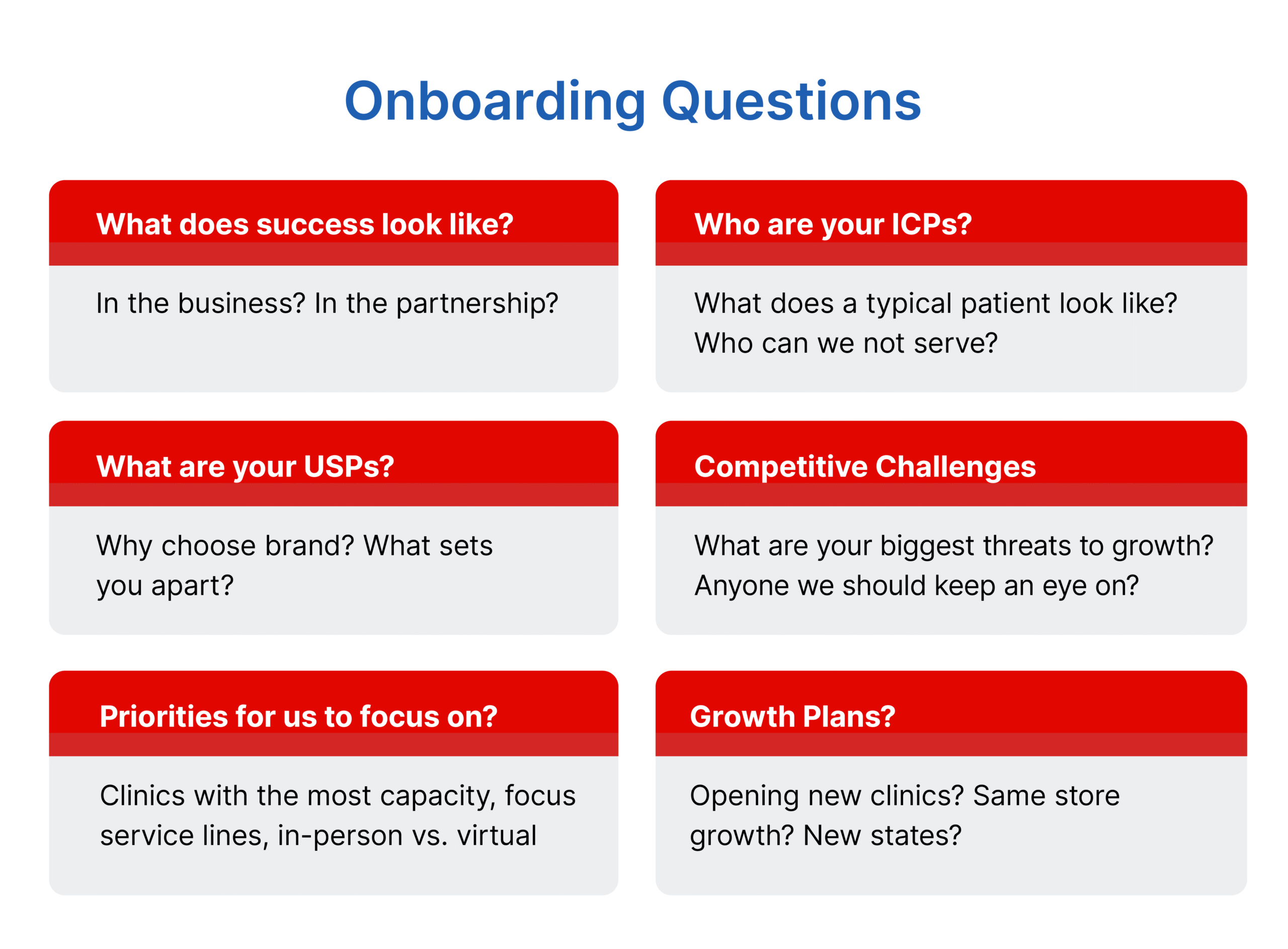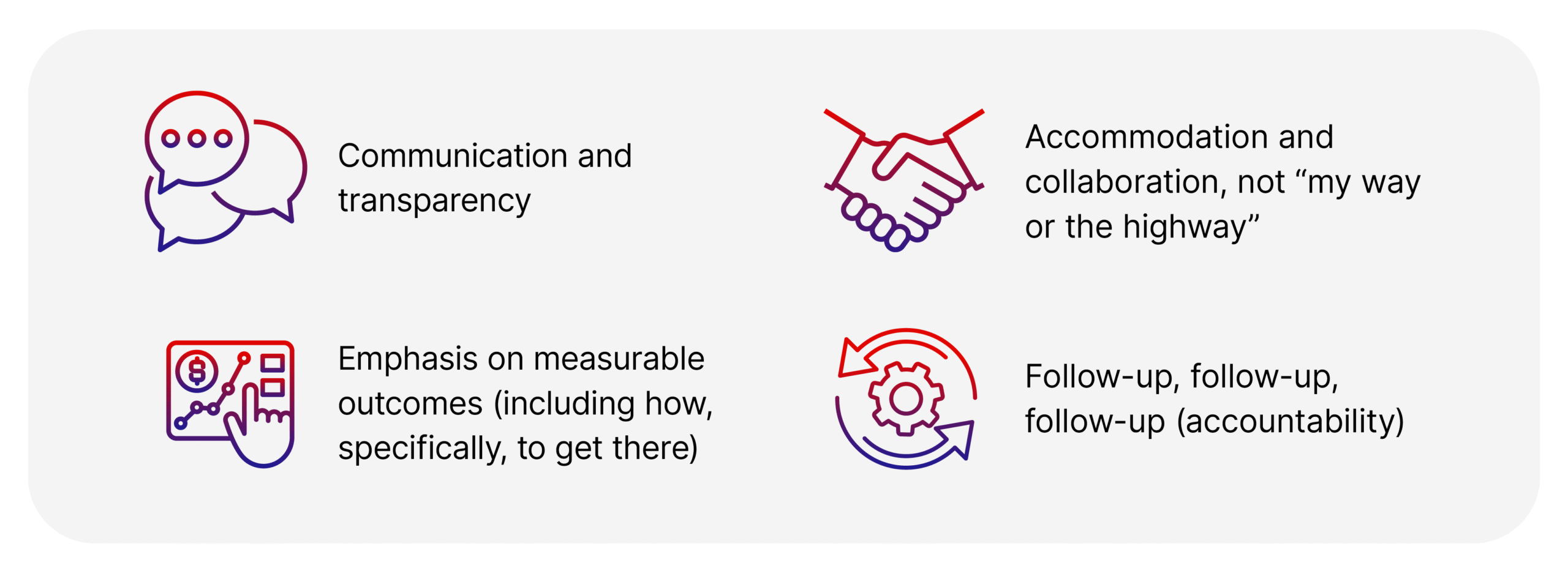Switching to a new digital marketing agency can seem…complicated. What should you expect throughout the process? What does your team need to bring to the table to smooth the transition? And what the heck is going to happen to your existing campaigns, conversion rates, and leads?
All good questions.
No healthcare organization has time for steps in the wrong direction, and we get that. Having been through the process a time or two, we’ve put together a quick guide to help you navigate the agency onboarding process.
Whether you’re expanding into new markets, optimizing underperforming campaigns, or parting ways with an agency that couldn’t scale with your business, this guide lays out what to expect, what to avoid, and what so-called onboarding nightmares you can finally put to rest.
It’s not that bad, we promise (at least, it doesn’t have to be).
What is the agency onboarding process flow?
Disclaimer alert: timelines, expectations, and outcomes will vary. Every business is different. Some groups come in with complex, multi-brand campaigns already in motion, while others are building from the ground up. That said, understanding each part of the onboarding process helps all teams move efficiently and avoid missteps.
We’ve outlined a standard 90-day framework. But depending on your service mix—whether that’s Paid Media, SEO, Creative, or all of the above—there may be slight variations. Once you’ve reviewed the proposal and signed the contract, here’s what to expect from a typical 90-day agency onboarding.

How your onboarding process flow can vary by service
Think of this as a rough guide, not a rulebook. Every healthcare organization is different, so depending on your services and goals, we’ll tweak the timeline and priorities to fit what works best for you.

Step 1: Kickoff call
Hi, hello, it’s nice to meet you.
This first call is a chance for all primary stakeholders on each side of the table to get acquainted with who they’ll be working with and set expectations around communication. It’s also a good time for the agency to lay out each step in the onboarding process, answer questions, and lay the groundwork for the next step, so that everyone is on the same page.
Step 2: Client questionnaire & information dump
No, we won’t ask you for your social security number or marital status (phew!). But we will want to get as much detail as possible around your existing marketing stack, strategy, team dynamics, goals, objectives, and any important documents that might be of use.
The questionnaire helps grease the wheels—the more time and attention you spend on it, the faster your new marketing team will be able to deliver value.

Step 3: Existing systems, campaigns, and channels audit
Sounds scary, but it’s really not. We’ll do a deep dive into your current marketing ecosystem. Our team will review your entire tech stack, APIs, internal systems, and marketing channel mix, ensuring everything is HIPAA-compliant. We’ll also take a close look at your existing campaigns and performance. This is a crucial step, as it’s an opportunity not only to see what you have and what’s working, but also what you don’t yet have and what you need to get results. As soon as the audit is complete, we’ll provide you with recommendations for your existing campaigns. We’ll also assume management of them and make sure they continue to deliver a steady flow of leads throughout the onboarding process.
Step 4: Strategy session
This is when we dive in—sometimes for a full day or two, to understand your healthcare organization’s goals, challenges, and patient acquisition needs. Our focus is on identifying clear, measurable outcomes that matter most to your team and crafting a strategic plan tailored to how we’ll achieve them.
What to expect
By around day 30 (often sooner), you’ll receive detailed audit reports, along with actionable recommendations for your current campaigns. Upon your review and approval, we’ll begin building your campaigns and will be ready to launch as we move into the second month of our partnership.
Step 5: Goal setting and KPIs
Again, any healthcare marketing agency worth its salt is going to be highly focused on measurable outcomes. What short-term and long-term goals do you want to achieve? Which KPIs will best track progress toward those targets? And how do these tie into your broader business objectives? We’ll want to know your existing business goals, marketing KPIs, and historical data so we can build from there.
For example, you might aim to acquire 100 new patients per month at high-capacity locations, 60 at smaller sites, and maintain volume where your brand is strongest, adjusting for market differences.
Step 6: Tech system integrations + dashboards
You have existing systems and technology, and so too will your agency. At this important step, we’ll work together to make sure everything is integrated properly and the right people have access to the right tools.
This lets us pull the right data together and build a custom dashboard just for your healthcare organization. We hope to have a clear, easy-to-understand view of everything about 30 days after we get started, once we have enough data flowing in.
Step 7: Launch (go time!)
The audit is complete, all systems are integrated, and the strategy has been approved. Now is the moment you’ve been waiting for: it’s time to launch all the campaigns! Your new campaigns are typically launched around day 31 to 40.
Step 8: Optimizing and reporting
Launching campaigns is good, but it’s just the first step. Continual improvement is an essential part of a successful healthcare marketing strategy. We don’t just set it and forget it. We closely monitor your campaign’s performance, communicate updates, and adjust campaigns to ensure we meet your strategic objectives.
This doesn’t just happen once or twice; it’s an integral part of our process and will continue throughout our partnership.
We don’t just monitor your campaigns—we stay ahead of the curve in the fast-evolving digital marketing landscape. We quickly adapt to Google algorithm changes, track emerging media trends, and optimize your campaigns to follow the latest best practices, making sure your results keep improving.
Campaign review and optimization
Cardinal will deliver campaign updates at regular intervals. Based on your service level agreement (SLA), you can expect:
- Weekly campaign updates
- Monthly reports
- Quarterly Business Reviews (QBRs)
If at any time you feel things aren’t working or if you want to discuss a new approach, you can reach out to your Account Manager.
Key considerations to remember when onboarding with a new agency
First, why did you decide to make the change in the first place? Is it because you don’t have enough resources in-house to execute a full-funnel strategy? Or maybe you had contracted with another agency, and the relationship started going south? Understanding the why can help you prepare for a smoother transition with the new agency that you end up retaining.
During agency onboarding, here are a few things to look for:

Once we get started, we encourage you to revisit the agency onboarding timeline we’ve provided, sample checklist items, and things to look out for as you begin this important transition.
This blog article provides a high-level overview of the onboarding process. For more information, download our complete guide. In it, we share sample checklists, common system integrations, and discuss how we migrate your existing campaigns to ensure there’s no dip in lead acquisition.

